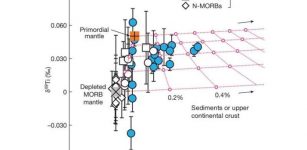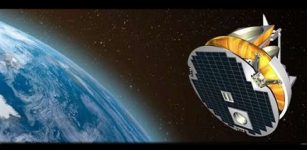Cosmic Rays Can Help Track And Effectively Study Violent Tornadoes
Eddie Gonzales Jr. – MessageToEagle.com – A new study suggests cosmic rays could help scientists track and study severe weather, including violent tornadoes.
Researchers combined local weather data with astrophysics simulations to explore using muon-detecting devices for remotely measuring tornado-producing supercell thunderstorms.
A tornado near Anadarko, Oklahoma, 1999. The funnel is the thin tube reaching from the cloud to the ground. The lower part of this tornado is surrounded by a translucent dust cloud, kicked up by the tornado’s strong winds at the surface. The wind of the tornado has a much wider radius than the funnel itself. Image credit: Daphne Zaras – Public Domain
Traditional tornado tracking uses drones or weather balloons, often requiring dangerous proximity to approaching storms.
By examining how storms impact muons (which are heavy particles moving at near-light speed), scientists can better understand underlying weather conditions.
“Atmospheric muons are sensitive to the properties of the atmosphere they travel through,” said William Luszczak, lead author of the study and fellow at Ohio State University’s Center for Cosmology and AstroParticle Physics, in a press release.
“Muons traveling through a thunderstorm will be measured differently than those passing through clear weather.”
Muons have unique applications, such as examining large objects like pyramids or detecting nuclear material. Luszczak’s simulations suggest that supercell thunderstorms slightly alter these particles’ number, direction, and intensity.
So, the researchers used a 3D cloud model accounting for variables like wind, temperature, and precipitation. They applied atmospheric data from a 2011 Oklahoma supercell to measure air pressure variations around a simulated storm over an hour.
Their results found that muons are indeed affected by the pressure field inside tornadoes, though more research is needed. The concept is promising for field use, as muons could predict and analyze weather patterns without placing instruments near tornados to measure pressure, according to Luszczak.
The muon particle detector Luszczak’s paper discusses is significantly smaller than major cosmic ray projects like Argentina’s Pierre Auger Observatory and Utah’s Telescope Array. If placed in tornado-prone areas like Tornado Alley, these detectors could complement standard meteorological measurements for tornadic activity.
The device’s size also influences how precise its measurements are.
The smallest detector researchers describe in this paper is 50 meters across, or about the size of five buses. But while such a tool would be portable enough to ensure scientists could place it near many different types of storm systems, being so small would likely cause it to face some errors in its data-gathering, said Luszczak.
Despite these potential setbacks, as supercell thunderstorms typically form and disappear in short periods, the paper emphasizes it may be well worth future scientists’ time to consider implementing a large detector in some regions – one that would likely be a permanent stationary establishment to catch as many muons as possible during severe weather events.
Current weather modeling systems are directly linked to when and where severe weather alerts are issued, using cosmic rays to strengthen those models would give the public a more detailed sense of a storm’s various twists and turns as well as more time to prepare for the phenomenon.
“Better atmospheric measurements around tornadoes improve our modeling and warning accuracy,” said Luszczak. “This promising concept is exciting to implement.”
Paper
Written by Eddie Gonzales Jr. – MessageToEagle.com Staff Writer











